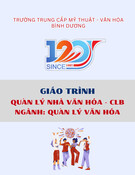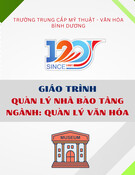
See discussions, stats, and author profiles for this publication at: https://www.researchgate.net/publication/375443748
Branding heritage in multi-cultural societies, with special references to
preservation discourses
ArticleinHBRC Journal · November 2023
DOI: 10.1080/16874048.2023.2272076
CITATIONS
14
READS
223
2 authors, including:
Mayas Nadim Ahmad Taha
Al Yamamah University
12 PUBLICATIONS29 CITATIONS
SEE PROFILE
All content following this page was uploaded by Mayas Nadim Ahmad Taha on 08 November 2023.
The user has requested enhancement of the downloaded file.

Full Terms & Conditions of access and use can be found at
https://www.tandfonline.com/action/journalInformation?journalCode=thbr20
HBRC Journal
ISSN: (Print) (Online) Journal homepage: https://www.tandfonline.com/loi/thbr20
Branding heritage in multi-cultural societies, with
special references to preservation discourses
Mayas Nadim Ahmad Taha & Dalia A. Abdelfattah
To cite this article: Mayas Nadim Ahmad Taha & Dalia A. Abdelfattah (2023) Branding heritage
in multi-cultural societies, with special references to preservation discourses, HBRC Journal,
19:1, 337-354, DOI: 10.1080/16874048.2023.2272076
To link to this article: https://doi.org/10.1080/16874048.2023.2272076
© 2023 The Author(s). Published by Informa
UK Limited, trading as Taylor & Francis
Group.
Published online: 06 Nov 2023.
Submit your article to this journal
View related articles
View Crossmark data

Branding heritage in multi-cultural societies, with
special references to preservation discourses
Mayas Nadim Ahmad Taha and Dalia A. Abdelfattah
College of Engineering and architecture, Al Yamamah University, department of architecture
and interior architecture, Ryiadh, Saudi Arabia
ABSTRACT
Heritage is the platform of intangible attributes embedded within the physical
urban values; it is the overlapping between urban forms and social history.
Heritage can be a brand value proposition that creates a unique base of strong
relationships between urban settings and users. The research is focusing on the idea
of heritage preservation from a different perspective, adopting branding techniques
and mechanisms to overlap the two disciplines in a study framework. Branding
heritage re-introduces heritage values from the marketing perspective, in which the
research reflects the idea of the place attachment and refreshes memories from the
economic dimension. The research proposes a structural framework that accom-
modates the literature domains of heritage preservation as tangible elements,
patterns, geometry … etc. and intangible values as spiritual, sense of place … etc.
mapped with the branding approaches. The aim of this research is to trace the
branding heritage tactics and examine the approach. The purpose is to preserve
heritage from deterioration and use its values as economic assets. The research
intends to validate the importance of marketing experience in branding heritage
process, using the symbols of tangible and intangible meanings and its significance.
The research anticipates studying marketing the heritage within multi-cultural
societies, in terms of contributing the heritage of some urban setting within the
heritage of others. The proposed structural framework reflects the mechanism of
branding heritage. Finally, the research concludes its findings by offering interpre-
tations of re-reading the users reflections and reviews to the concept of branding
heritage upon an existing project setting.
ARTICLE HISTORY Received 7 August 2023; Revised 8 October 2023; Accepted 12 October 2023
KEYWORDS Branding heritage; urban tangible values; place attachment; multi-cultural societies; con-
servation; branding Strategy
Introduction
Heritage is that part of the present that was drawn from the past, which would
be said that ‘a society’s identity is based on its heritage’. It is that combination of
CONTACT Mayas Nadim Ahmad Taha M_taha@yu.edu.sa department of architecture and
interior architecture Alryiadh, College of Engineering and architecture, Al Yamamah University, KSA,
Riyadh 12271, Saudi Arabia
HBRC JOURNAL
2023, VOL. 19, NO. 1, 337–354
https://doi.org/10.1080/16874048.2023.2272076
© 2023 The Author(s). Published by Informa UK Limited, trading as Taylor & Francis Group.
This is an Open Access article distributed under the terms of the Creative Commons Attribution-NonCommercial License
(http://creativecommons.org/licenses/by-nc/4.0/), which permits unrestricted non-commercial use, distribution, and
reproduction in any medium, provided the original work is properly cited. The terms on which this article has been
published allow the posting of the Accepted Manuscript in a repository by the author(s) or with their consent.

qualities from culture and traditions within an urban context. Heritage values
reflect the place attachment and refresh memories created from layers of
emotions. It embraces feelings that stand still even when the urban itself has
been swept away [1]. In that sense, heritage can be approached from the
branding perspective, that provides distinctive relationships between the tar-
geted community and the heritage values from the economic dimension.
Branding heritage can tackle the glory of the past and the authenticity of the
local values, within the dynamic movements of the modern diverse societies
[2]. The integration of multi-diverse heritage in the local development pro-
cesses creates a place-branding strategy, especially in Mega multi-cultural
cities [3].
Literature review
The meaning of the word (Heritage) is quite broad, and it encompasses many
aspects, part of our heritage is Tangible, as the built heritage which symbolize
the people identity and history [4]; aesthetic, archeological, symbolic values
and historical architecture details refers to our inheritance. This built heritage
has been passed down from one generation to the next. It is one of the
fundamental essentials that constitutes the comprehensive memory and the
cultural identity, which characterize society [4].
On the other hand, the Intangible heritage is the expression of history
through heritage qualities. It is recognized as a basic resource for asserting
further development for cultural identity (Figure1) [5].
However, the role of heritage is not just to maintain and support cultural
identity. In other words, heritage and its qualitative\quantitative elements
can form a social constructive function for the cultural identity, in which
heritage values can be represented through physical qualities such as build-
ings, monuments, districts, urban heritage villages, landscapes, sculptures,
plans, books, motifs, paintings. In addition to nonphysical qualities as the
musical traces, the distinguished cuisine, even the substantial events as feasts
and festivals, all the memories which are related to certain community tradi-
tions behaviors, customs, beliefs … . etc., by appreciation the spirit of the
place and its physical intangible components, in addition to the importance
of adapting its local contexts with more conservation forms of heritage
preservations.
Simply heritage is ordering values that organize the relation between
human’s needs and their urban resources, which arrange their behaviors.
Finally, it gives an image of different factors fuse, forming an identity of the
urban setting through traditions and behaviors [6].
338 M. N. AHMAD TAHA AND D. A. ABDELFATTAH

Heritage; unlocking the potential values
Heritage is that combination of qualities from culture and traditions, learning
from the past became an appreciated reason for conserving its values for the
coming generations, as keeping the essence of the heritage of its uniqueness
and locality [4]. This heritage has been formed and developed through years
of people’s communications and interactions, and it also has been formed by
the interaction between human life and a specific urban context.
This socialization occurs within urban characteristics that define the
relation between inhabitants and their surrounding urban context [5].
Heritage creates a wave of harmony in which humans are trying to fulfill
their needs through managing all the surrounding urban sources. Getting
attached to urban heritage creates a unique sense of place. This is the
reason why many civilizations, both in the developed and developing
worlds, place a high value on heritage and take a great deal of care in
maintaining its authenticity [6].
Branding; marketing the identity
The idea of Branding is to establish a long-term relation with the potential
community users by integrating various resources of local and regionally
designed social, economic, and cultural initiatives connected to their char-
acter [7]. Branding, moreover, may struggle in a massively competitive envir-
onment, where the community experiences great exposure to various brands
daily [8], that demands strong brand identities, elite product quality, and user
attachments on high levels [9]. In order to maintain a sustain brand, the
academic literature about branding and users’ behavior has emphasized a
proposal to attain the aim, by associating brand-specific features with com-
munity users’ aspirations to strengthen their local identity [9].
Accordingly, the branding process is preferred to rely more on the local
and authentic values. Place branding is a strategy that establishes deeply
Figure 1. Tangible and intangible Heritage.
HBRC JOURNAL 339









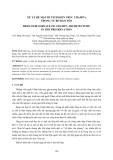

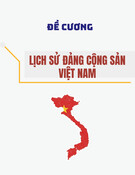
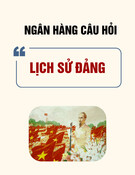





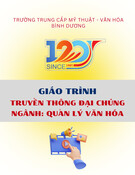
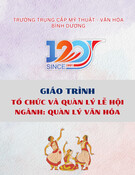
![Giáo trình Tổ chức và Quản lý Hoạt động Văn hóa Thông tin Cơ sở (Ngành Quản lý Văn hóa - Trung cấp) - Trường Trung cấp Mỹ thuật - Văn hóa Bình Dương [Mới nhất]](https://cdn.tailieu.vn/images/document/thumbnail/2025/20251110/kimphuong1001/135x160/17861762748492.jpg)
